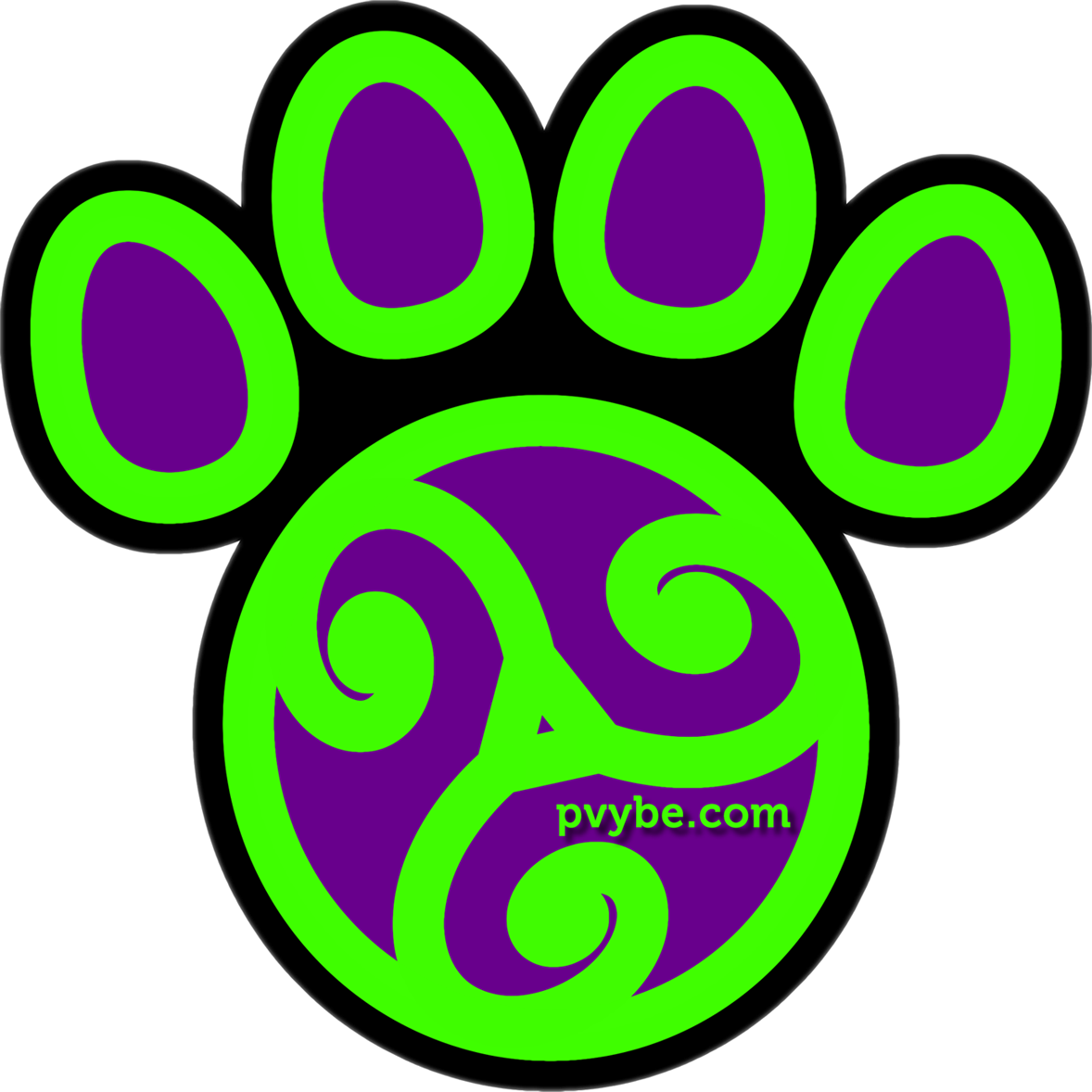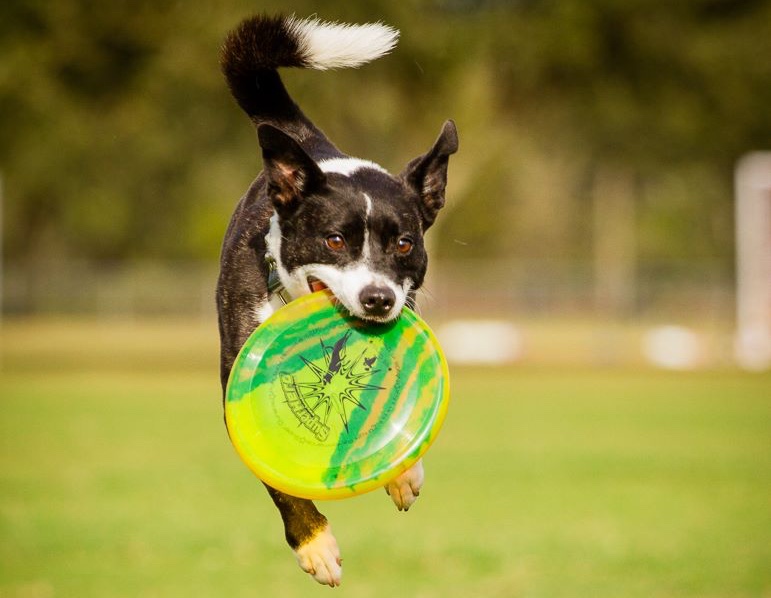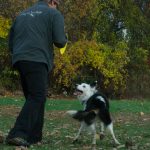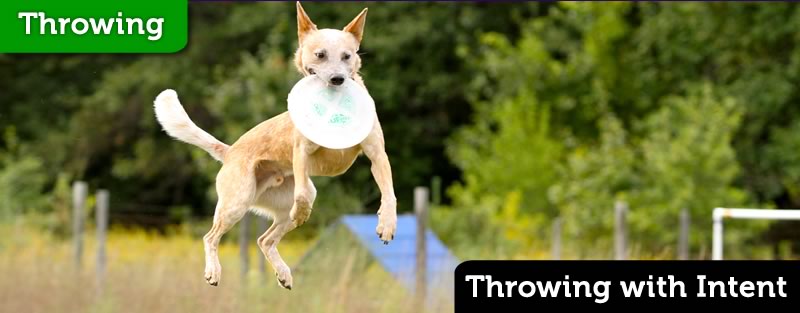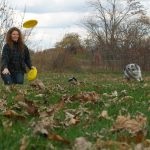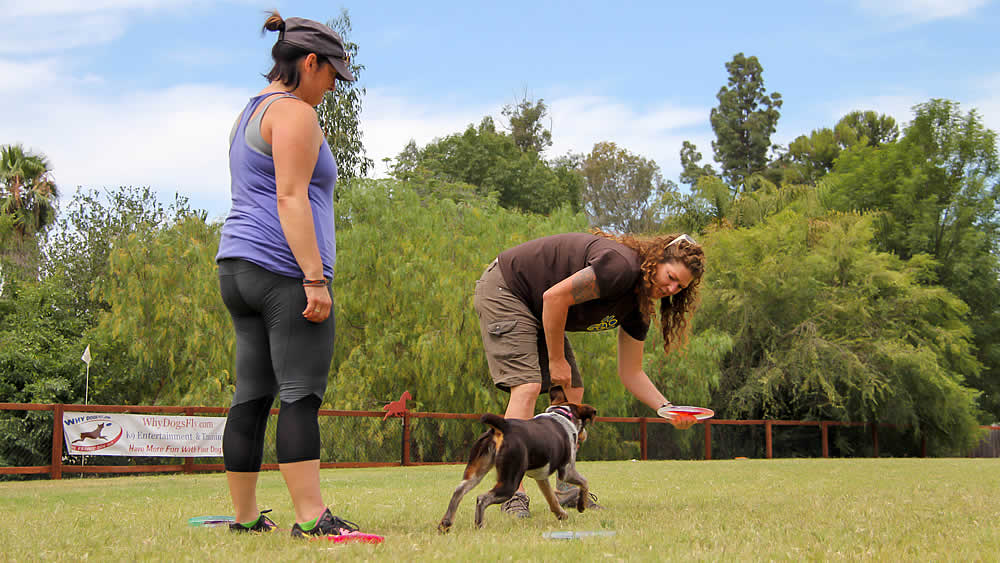Spot Training as Set Up Move
 The last few weeks we’ve really been using spot training for our indoor training sessions. Our Set up looks like this:
The last few weeks we’ve really been using spot training for our indoor training sessions. Our Set up looks like this:
Our space is long and setting an appropriate line, running the length of the turf (from Spot to Motorcycle) is important because we just don’t have enough width to be able to do things across the short side of the field (from Balls to Table).
Our turf is 3/4” padded athletic turf, and while not an ideal surface, it does allow us to do a good bit of work with our dogs. We’ve been doing walk throughs with our dogs – doing tricks and sequences at 1/2 speed and intensity as a result of our space and footing limitations. We already had spots and pedestals set up in the studio that we use for staging dogs that are waiting to play and it just so happened that we had a wobble board laying out there one day and Apryl used it. That board has been getting a lot of work since then…
What is Spot Training
Spot training is an absolutely awesome skill that combines Targeting and a Stay (Duration BehaviorAny behavior performed until the handler wants it to stop is a Duration Behavior. Duration Behaviors have 3 parts. There is an action,”Yes!”. Then there is the duration part filled with Classical Conditioning... More). The dog learns to go to a particular spot (usually a mat of some sort or dog bed) and stay (or do something else while there).
Spot training has amazing applications for everything from day to day management and housemanners to reactive or aggressive dogs.
We’re going to use it to shave tons of time and frustration out of our disc dog training.
Why it Works and Spot Variations
Spot training is valuable because it provides a black or white understanding of position. One is either on the spot or is not on the spot, those are just the facts.
Without a spot, the concept of holding position can become grey. Twitching toes becomes squirming. Squirming becomes squirming forwards, becomes creeping up, and so on. The dog can move 20 feet without the handler even noticing. I confess to doing this all the time, BTW… as I say, not as I do…
So what we have with Spot Training is a concrete position. The CriteriaCriteria is a key concept of dog training. Criteria is what exactly the handler is looking for out of the dog at any given time as a metric for success. Criteria is the... More is very static, is clear and is easy to understand.
Pedestal
 A pedestal
A pedestal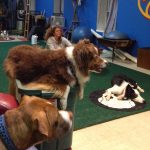 Spot is a “go to a place”, or “go to a mat” behavior. This means that the dog seeks out and performs a duration behavior on a spot of the handler’s choosing. A... More is a raised spot. It’s a table, a chair, a stool, an exercise ball, a stump, boulder – anything the dog can get on top of. In the case of a table, you are either on or off the table, there’s really no in between. It’s black and white. They get off, they have to perform a behavior to get back on which when offered freely shows understanding and self control over position.
Spot is a “go to a place”, or “go to a mat” behavior. This means that the dog seeks out and performs a duration behavior on a spot of the handler’s choosing. A... More is a raised spot. It’s a table, a chair, a stool, an exercise ball, a stump, boulder – anything the dog can get on top of. In the case of a table, you are either on or off the table, there’s really no in between. It’s black and white. They get off, they have to perform a behavior to get back on which when offered freely shows understanding and self control over position.
It is very easy to get a dog to stay on a pedestal. I think the blatant on and off nature of the platform and the effort required to get on and off provides sharp contrast. It is very black and white.
Using a Pedestal for spot training is about Action. This is where I like to start out. I like my dogs to fly around and be ready to roll. But not all dogs need to fly around and be on edge like that. Some need to relax.
“Chill, man… Chill.”
 Mat or Traditional Spot
Mat or Traditional Spot
The traditional spot, usually a mat or a dog bed, functions the same as a pedestal, in the black and white, on and off nature and conceptual understanding and control over position, but it is a bit more laid back. It’s just an object on the ground. The dog learns to go over to the mat and lie down and good things happen.
This spot is a bit more grey than the Pedestal because there is not that much contrast between the spot and the surrounding floor. They are on the same plane. Also it requires less effort on the dog’s behalf which means it is less memorable as a markable moment – there’s no real defined behavior. We have to define that for them.
Random or Handler Defined Spot
This is an advanced maneuver, and is really nothing more than a down stay, but it comes from a spot foundation meaning that if Spot is taught well and fully generalized, the handler should be able to create a spot out of thin air and have the dog understand that going to that spot is a good thing and should be done.
Threshold
Not quite a Spot, but the same concept…
A threshold can be made out of any line that is perpendicular to the dog’s path. A threshold from the kitchen to the Living Room, a doorway, a crate door, a leash on the ground, etc. Spot training can be used or modified to transfer the Spot behavior to any threshold.
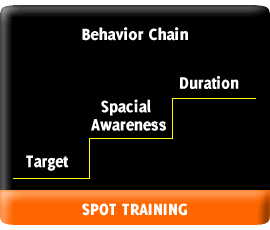 Spot Training 101 – Backchaining the Spot
Spot Training 101 – Backchaining the Spot
There are several aspects to the Spot behavior that are important and that can be honed in on and focused on to improve the behavior.
We’re going to back chain this because I’m teaching the lesson and I don’t want this exercise to be 101 things to do with a box.
We could spend a ton of time shaping this – shaping the target, then getting the idea of foot placement, then getting duration – that would be a front chain, building or assembling the behavior. It would be a training challenge and provide great understanding of the component behaviors but it would take a lot of time.
Instead of building or assembling the Spot behavior: Target >> Spacial Awareness >> Duration by moving up the staircase. We’re going to start at the top with Duration and work our way backwards, falling into the Behavior.
Tools
- Mat or Table
- Lots of Cookies
- Good Timing
- A Generous Heart
Ready?… Go
Set up your Spot in a low distraction environment.
Set yourself up close to the spot. Wait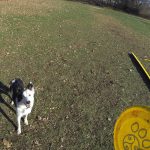 Waiting on cue and situationally is extremely important for disc dog freestyle training. The competition field might not see too much waiting going on as everything is supposed to be happening in flow,... More for the dog to notice the spot. MarkShort for “Positive Marker”, a Mark is a word or signal given at the exact moment a desired behavior is performed. It’s like a clicker. Mark can also mean the act of marking... More the dog noticing the spot and use reward placement to put the dog on the spot.
Waiting on cue and situationally is extremely important for disc dog freestyle training. The competition field might not see too much waiting going on as everything is supposed to be happening in flow,... More for the dog to notice the spot. MarkShort for “Positive Marker”, a Mark is a word or signal given at the exact moment a desired behavior is performed. It’s like a clicker. Mark can also mean the act of marking... More the dog noticing the spot and use reward placement to put the dog on the spot.
In the case of a pedestal, you will mark the dog looking at the spot and put the reinforcement where he must jump up onto the pedestal to get it. Yes! Then the cookie shoots up to where the dog’s head should be when sitting atop the pedestal. No go for the cookie? No cookie. Dogs don’t earn reinforcment, they earn the opportunity for reinforcement.
If you are using a traditional mat, you will mark the dogs interest in the mat and use reward placement to move the dog fully onto the mat.
Once we have the dog on the spot we’re going to start shoveling food in there. CookieA Cookie is traditionally thought of as a food treat given as positive reinforcement. In that definition, a cookie is a discrete piece of food reinforcement. In many dog training discussions, the idea... More,cookie,cookie,cookie, one a second for 20 seconds. Then we’re going to tell them Off – the cue you use for getting off the sofa – and toss a cookie over there a ways – not too far, OK?
Repeat.
Adding Value
All we are doing here is adding value to the spot in terms of duration. In 2 reps we should be able to drop our rate of reinforcement pretty drastically and maintain duration on the spot. But don’t get stingy.
I said above,”All we are doing here is adding value to the spot…”, but that’s not entirely true. That’s really what we’re focusing on, but we are also getting the spacial awareness of being on and off and the spot through the reward placement of the tossed cookie. Isn’t back chaining brilliant?
So now we have a dog that likes the spot, will acknowledge the spot, has been heavily reinforced for the spot, we should be able to exercise a little patience and have this happen all on it’s own.
Be mindful of your criteria. If you are upping the ante from acknowledging the mat to being on it don’t set your criteria at the finished 4 feet on and a sit. Take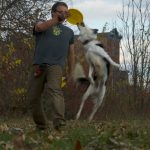 A Take is a cued Bite that replicates the placement and timing of a throw. Usually used with overs, vaults, and flips, the Take is a powerful teaching tool for creating habitual leaping... More the 2 feet on and use your reward placement to finish it.
A Take is a cued Bite that replicates the placement and timing of a throw. Usually used with overs, vaults, and flips, the Take is a powerful teaching tool for creating habitual leaping... More the 2 feet on and use your reward placement to finish it.
Add value to the spot and the duration with lots of cookies the release the dog. The dog will go back to where the reward happens. Be sure that you are asking the dog Off – and don’t be afraid to reward the Off. It just makes getting on that much better.
The Release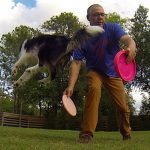 Release has many meanings in disc. Throws and throw variations can be referred to as releases. Sometimes you talk about the dog releasing something, the toy, or the environment, as in to stop... More is the defining aspect of a duration behavior. Without a release, there can be no duration – duration has to have a beginning and an end.
Release has many meanings in disc. Throws and throw variations can be referred to as releases. Sometimes you talk about the dog releasing something, the toy, or the environment, as in to stop... More is the defining aspect of a duration behavior. Without a release, there can be no duration – duration has to have a beginning and an end.
What you should see quite early on is that the dog is moving very quickly to the spot and is eager to stay there. If your dog starts getting off on cue then turns immediately around to get right back on, you should quit and go sit down.
After you dismiss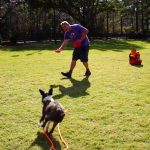 If a dog is dismissed, it means the handler is "off limits". Dismissal does not mean the dog has to leave, just that the handler is not available. Dismissal is a valuable drive... More him and sit down, watch your dog out of the corner of your eye and odds are within the first couple minutes, he will go work the spot to see if it works when you are not there. If he does, jackpot it – shower him with Bacon!
If a dog is dismissed, it means the handler is "off limits". Dismissal does not mean the dog has to leave, just that the handler is not available. Dismissal is a valuable drive... More him and sit down, watch your dog out of the corner of your eye and odds are within the first couple minutes, he will go work the spot to see if it works when you are not there. If he does, jackpot it – shower him with Bacon!
Good job, call it a day.
You’ll want to be sure to generalize your position as a handler, work with some toy reinforcement and change locations in subsequent sessions. Keep them short and successful.
You might want to change the off cue to your release cue, you might not. I personally use off or my Dog’s name…
 Spot Training and Disc Dogs
Spot Training and Disc Dogs
Now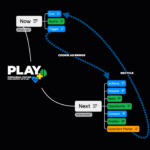 The Now Phase is an integral part of the Play Cycle in the Play+ training philosophy. It embodies the current, immediate interaction between the handler and the dog, anchoring them in the present... More that you have a beautiful and solid spot, go ahead and put it to use. As you can see by the diagram of our studio, we don’t have a ton of room, but by using the spot we can totally work a linear back and forth vault sequence. We can also simulate the dog returning to the handler to work on the flow of our setup moves.
The Now Phase is an integral part of the Play Cycle in the Play+ training philosophy. It embodies the current, immediate interaction between the handler and the dog, anchoring them in the present... More that you have a beautiful and solid spot, go ahead and put it to use. As you can see by the diagram of our studio, we don’t have a ton of room, but by using the spot we can totally work a linear back and forth vault sequence. We can also simulate the dog returning to the handler to work on the flow of our setup moves.
Once your dog realizes that going to the Spot earns him the right to play with the disc, you’re all set. The dog will go hang out on the spot when there’s no disc going on. During training you can set your dog up at whatever distance you want and do so easily.
Remember how hard it was to set the dog up for training that leg vault?
It’s a little easier now that your dog goes out there and sets up himself, isn’t it?
